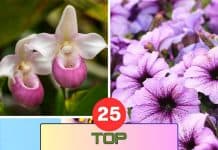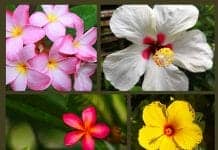
Texas is a large state with its own floristic region, having more than 5,000 species of native flowering plants. Because of its diverse landforms, Texas offers many famous blooms for visitors and residents. In addition, the lovely natural blooms along the roadsides and the fields are nature’s treasures that Texas offers.
Table of Contents
- Top 25 Texas Flowers
- 1. Texas Bluebonnet
- 3. Texas Blazing Star
- 4. Blackfoot Daisy
- 5. Texas Spiderlily
- 6. Texas Lantana
- 7. Mountain Pink
- 8. Hill Country Rain Lily
- 9. Fleabane
- 10. Butterfly Milkweed
- 11. Buckley’s Yucca
- 12. Indian Blanket
- 13. Pink Evening Rose
- 14. Winecup
- 15. White Prickly Poppy
- 16. American Basket-Flower
- 17. Eryngo
- 18. Water Primrose
- 19. Texas Shrimp Plant
- 20. Sweet Shaggytuft
- 21. Purple Pleat-Leaf
- 22. Six Angle Fold Wing
- 23. Crow Poison
- 24. Texas Tuberose
- 25. Texas Wrightwort
Top 25 Texas Flowers
1. Texas Bluebonnet
| Plantae | Fabales | Fabaceae | Lupinus | Lupinus texensis |
- Plant Type: Annual herb.
- Common Names: Texas bluebonnet. Bluebonnet. Texas Lupine. Buffalo Clover. WolfFlower, Conejo.
- Color: Blue, white
- Flower Dimensions: Each floret is 0.39 to 0.79 inches long. The Bluebonnet flower pedicelWhat is pedicel?The stalk of an individual flower in an inflorescence or the stalk of a grass spikelet. has a length of 0.24- 0.47 inches.
- Flowering Seasons/ Months: Springtime.
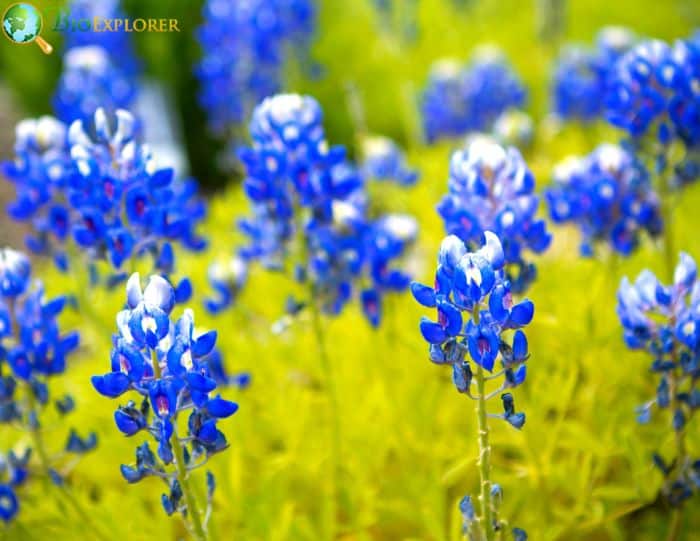
Lupinus texensis is a flowering plant of the family Fabaceae. Some of the main species of Bluebonnets are growing naturally only in Texas.
- The leaves of the Texas Bluebonnet are velvety and palmately compound. Usually, this species has five leaflets.
- The stems of the Texas Bluebonnet are branching. Approximately the stems are 6-18 inches in length.
- The clusters of up to 50 flowers are found on the stems. The flowers of the Texas Bluebonnet are pea-like and blue. They are densely arranged in spikes with ice white at the terminal tip.
- The flowers of L. texensis are conspicuous and fragrant. They are bisexual.
- Plants belonging to the genus Lupinus[1] are toxic, specifically the seeds. The seeds of the Texas Bluebonnet have a high level of alkaloids that are toxic to humans and animals. Also, the seed coat of the Bluebonnets is tough. They also have a low germination rate. This makes growing bluebonnets from seeds extremely difficult.
- Like other related species of lupines, the Texas Bluebonnet is considered the State flower of Texas. The petals of the bluebonnets resemble the bonnets of the pioneer women. This is how the species got its name.
- The Texas Bluebonnet is also called “Conejo“[4] because the white tip of the flowers resembles bunny tails. Conejo is a Spanish word that means “rabbit“.
- Many tropical plants were killed during the 2021 Texas winter storm, but not the L. texensis. The rosettes of the Bluebonnets continue to grow after the freeze.
- The Bluebonnets attract Rhizobium bacteria that convert nitrogen into a form that enriches the soil. This, in turn, makes the soil healthy and habitable for other plants.
2. Texas Bluebell
- Plant Type: Annual, herbaceous perennial.
- Common Names: Blue Gentian, Lisianthus, prairie gentian, Texas Bluebell.
- Color: Pink, purple, lavender, white.
- Flower Dimensions: 1-3 inches.
- Flowering Season/Months: Fall, Summer.
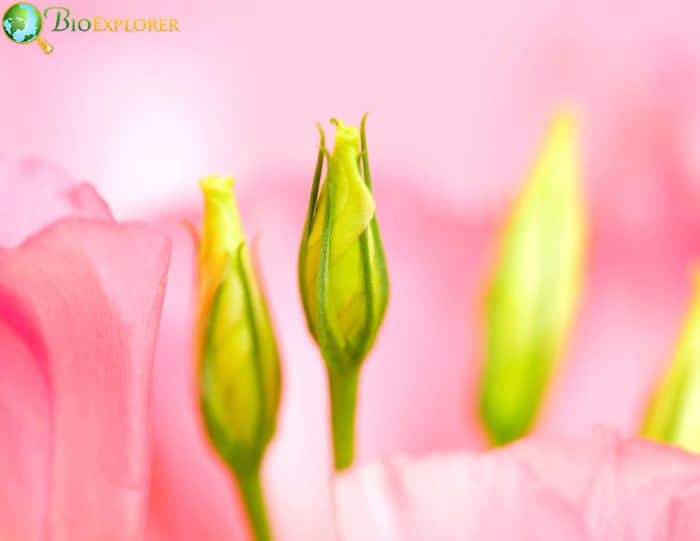
Texas Bluebell is an herbaceous perennial plant of the family Gentianaceae. This species is native to Nebraska, Colorado, Kansas, and Texas.
- The stem of the Texas Bluebell is not aromatic. It is straight. The stem can be single or branching. It can rise to a height of 3 feet.
- Texas Bluebells have waxy, oblong/ovate, and gray-green leaves. They can be 3-6 inches in length.
- The flowers of the E. grandiflorum are gentian-like. These flowers are showy and bell-shaped in pink, purple, lavender, or white.
- The Texas Bluebells have large flowers and are the favorite of flower enthusiasts.
Interesting Facts about Texas Bluebell
- The genus name Eustoma comes from the Greek word “eu” and “stoma“, which means “good” and “mouth or a pretty face“. This describes the showy flowers. The specific epithet “grandiflorum“[5] means large flowers.
- The E. grandiflorum[6] is formerly known by the scientific name Lisianthus russellianus.
- The single form of the Texas Bluebells resembles the full-blown Tulips or Poppies, while the double form resembles that of the Roses or Peonies.
- The essential oils[7] extracted from the E. grandiflorum plant parts have antimicrobial and antifungal activities. The research[8] findings show the effectiveness of E. grandiflorum when tested against specific bacteria and fungi.
- The cut flowers of the E. grandiflorum requires vase care attention to attain postharvest life and quality increase. Research[9] showed that applying pectin-derived oligosaccharins in vase solutions maintains the quality of the cut flowers.
3. Texas Blazing Star
| Plantae | Asterales | Asteraceae | Liatris | Liatris punctata var. mucronata |
- Plant Type: Perennial herb.
- Common Names: Texas Gayfeather, Texas Blazing Star, Texas Liatris, Cusp Liatris, Cusp Blazing Star, Cusp Gayfethear, Narrow-leaf Liatris, Narrow-Leaf Blazing Star, Narrow-Leaf Gayfeather.
- Color: Pink, purple
- Flower Dimensions: 0.16 inches across.
- Flowering Seasons/Months: August to December.
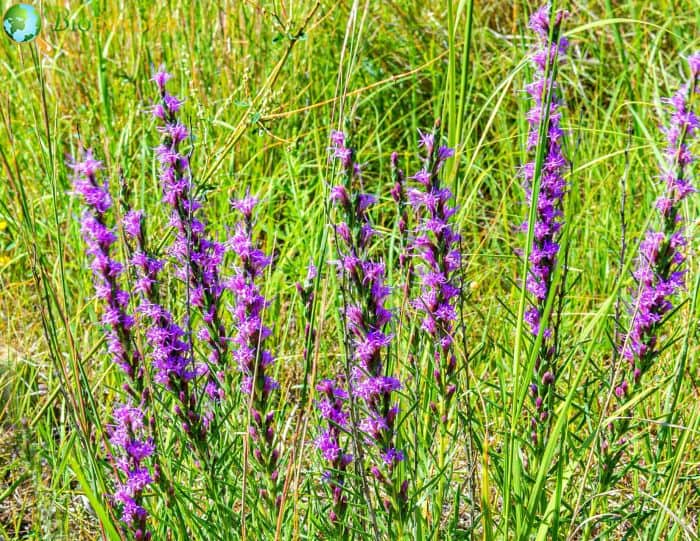
Liatris punctata var. mucronata is a perennial herb of the Asteraceae family. This plant is upright, with many stems at the base. In Texas, Liatris punctata var. mucronata is a native plant.
- The stems of the Texas Blazing Star are 4 mm in diameter. It is orange-red to purplish when aging. The stems are glabrous, sometimes delicate, and long hairs are present. The stem leaves are narrow and lance-shaped.
- The leaves of the Texas Blazing Star are simple and helically alternate. The stipules are absent. Sometimes, fine hairs are found near the base of the young leaves.
- The flowers are bisexual and radial. The calyxWhat is calyx?A collective term for all the sepals of a flower; the lowermost whorl of floral organs (Plural form is calyces). has feathery capillary bristles. The corollaWhat is corolla?A collective term referring to the petals of a flower. is tube-barrel shaped and consists of 5 lobes. Each lobe is approximately 1.5-2 mm in length.
- The flowers of the Texas Blazing Star are densely congested in fluffy spikes. They are showy.
- The plant of the Texas Blazing Star can grow to a height of 1-3 feet tall and 12-18 inches wide.
Interesting Facts about Texas Blazing Star
- Punctata[10] means “dotted“. This implies the tiny resin dots found on the undersides of the plant’s leaves and bracts.
- The Texas Blazing Star[11] sometimes needs 2 years to bloom. These flowers are like a sunny spot and dry to medium soil. Overwatering of the plant can cause the rotting of the roots.
- L. punctata[12] is also used in traditional medicine. The pulverized root of the plant is eaten for improved appetite. Also, the boiled root is a remedy for swelling.
- The scientists isolated pyrrolizidine alkaloids from the root of the host plant Liatris punctata.[13] These were also isolated from the parasitic plant Castilleja integra.
- In traditional medicine[14], the roots are chewed, and the juice is swallowed. Then, it is used to treat swollen testes.
4. Blackfoot Daisy
| Plantae | Asterales | Asteraceae | Melampodium | Melampodium leucanthum |
- Plant Type: Perennial herb.
- Common Names: Blackfoot Daisy, Rock Daisy, Plains Blackfoot, Arnica.
- Color: White, yellow
- Flower Dimensions: 1-3 inches.
- Flowering Seasons/ Months: March to November.
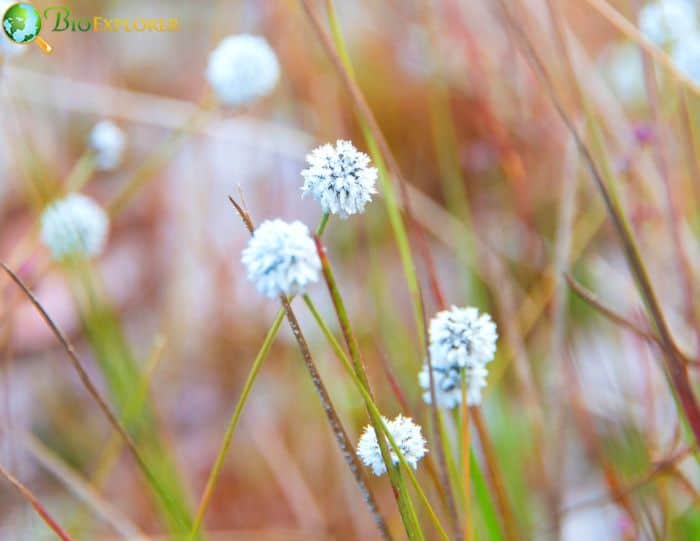
Melampodium leucanthum is a perennial herb of the family Asteraceae. This low, round, bushy plant can grow to a height of over 6 inches.
- Blackfoot Daisy is a long-blooming perennial wildflower.
- The leaves of the Blackfoot daisy are narrow. They are linear-oblong, simple, and opposite. They measure 1 inch in width.
- The flowers of the Blackfoot daisy are conspicuous and fragrant. The flower heads of the M. leucanthum comprises about 9-13 broad white rays surrounding the yellow central disk. They are daisy-like.
- The flower heads are honey-scented. The flowers are solitary and are found in the terminal of the slender stalks.
Interesting Facts about Blackfoot Daisy
- Unlike most wildflowers of Texas that bloom for a few weeks, the Blackfoot Daisy[15] starts blooming in late spring and continues into fall.
- M. leucanthum is called Blackfoot because there is a small, foot-shaped bract (reduced leaf) at the underside of each white ray flower. These bracts will turn black at maturity.
- The genus name Melampodium is from the Greek words “melas“ and “podos“ which mean “black” and “foot” respectively.
- A group of medical and pharmacological researchers from the University of Texas Health Science Center in San Antonio has isolated 5 compounds from the Blackfoot Daisy’s leaves and branches. All the isolated compounds effectively fight human prostate and cervical cancer cells.
- The Blackfoot Daisy resembles White Zinnia (Zinnia acerosa) at first glance. Still, the Z. acerosa only has 4-6 broad white rays, and its narrow base comprises several overlapping scales. The Blackfoot daisy has 8-10 broad white rays.
5. Texas Spiderlily
| Plantae | Asparagales | Amaryllidaceae | Hymenocallis | Hymenocallis liriosme |
- Plant Type: Perennial herb.
- Common Names: Texas Spiderlily, Spring Spiderlily, spider lilyLily, Western Marsh Spiderlily.
- Color: White
- Flower Dimensions: 7 inches wide.
- Flowering Seasons/Months: February to September.
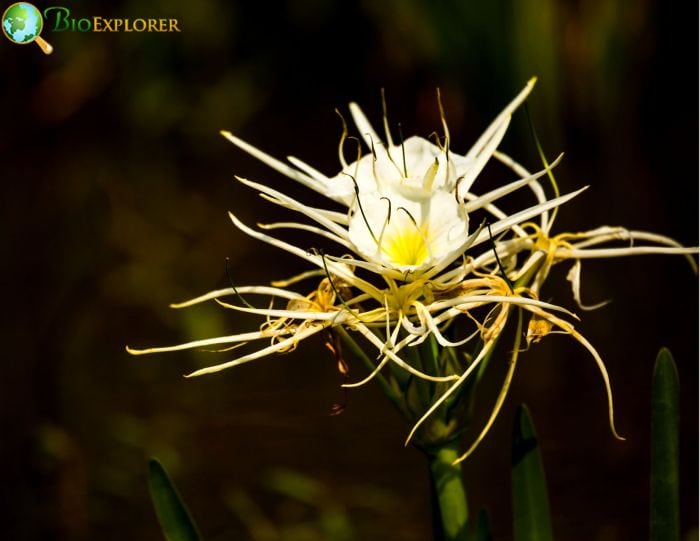
The Texas Spiderlily is an elegant and unusual-looking perennial herb in the family of Amaryllis. The H. liriosme plants are native to Texas.
- The Texas Spiderlily stems can reach 1-3 feet tall.
- The leaves of the Texas Spiderlilies are glossy, simple, and deciduous. They measure 6-30 inches in length and 1 inch in width.
- The fragrant flowers of the H. liriosme is found at the top of the stem. There are 2-3 blossoms.
- Each flower forms a tube and comprises 3 petals and 3 sepals. The flower tube is narrow but spreading, measuring 2-4 inches long.
- Texas Spiderlilies perform best in humus-rich soil that is consistently moist to wet.
Interesting Facts about Texas Spiderlily
- The genus name of Texas Spiderlily is derived from the Greek words “hymen” and “kallos” which means “membrane” and “beauty“. This describes the membrane of the flower that unites the stamens. The specific epithet “liriosme[17] ” means fragrant lily.
- Despite the name, the Texas Spiderlily[18] does not belong to the family of lilies. This species is under the Amaryllis family. True Lilies have a superior ovary. The Spiderlilies[19] have inferior ovaries.
- The H. liriosme species is sometimes confused with Crinum americanum. Both species have big white flowers and thrive in wetlands.
- All parts of the H. liriosme species are poisonous. They contain the toxic alkaloid lycorine. Therefore, it is not recommended to touch or eat the plant parts.
- The Texas Spiderlily’s bulbous roots help stabilize the water bank and reduce erosion. Also, the roots serve as the habitat for beneficial macroinvertebrates.
6. Texas Lantana
- Plant Type: Perennial Shrub.
- Common Names: Texas Lantana, Calico Bush.
- Color: Red, orange, yellow.
- Flower Dimensions: Less than 1 inch.
- Flowering Seasons/Months: Spring until the first frost.
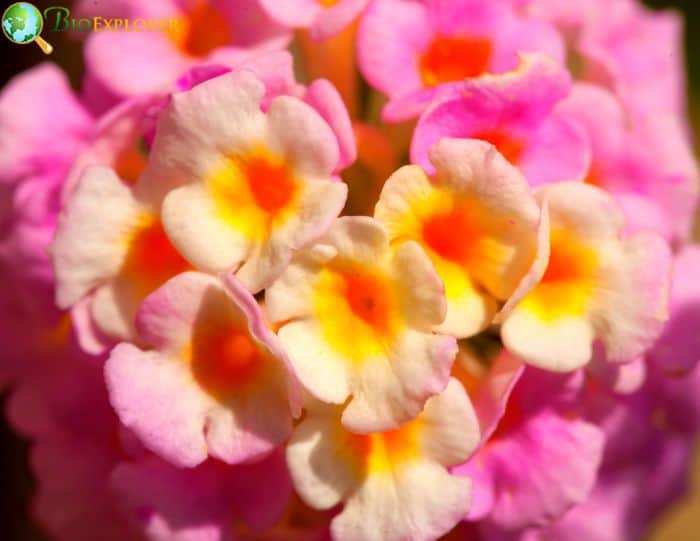
Lantana urticoides is a spreading perennial shrub of the Verbena family. This shrub is much-branched. Sometimes, prickles are present in the branches.
- The Texas Lantana shrub is slow-spreading and grows best in poor, sandy, and gravelly soils.
- The barks of the Texas Lantana are light-gray to light brown. They are flaking.
- The leaves of the Texas Lantana are ovate, aromatic, and opposite. The tips are pointed, and the bases are flattened. The margins are coarsely toothed. These leaves can measure up to 2.5 inches in length.
- The flowers are tubular in dense rounded clusters. They are in peduncles that extend beyond the leaves.
- Each flower is composed of four flared lobes. The leafy bract subtends each flower.
Interesting Facts about Texas Lantana
- The leaves of the Texas Lantana[20] can irritate when touched. In addition, they are poisonous to animals and humans.
- The Lantana flowers[21] symbolize rigor and rigidity.
- The original name of the L. urticoides[22] is Lantana horrida. The scientific name Lantana horrida refers to the leaves strong smell.
- Botanist August von Hayek renamed the plant from L. horrida to L. urticoides. The “urticoides” means “like a nettle” because the plant resembles the Nettles of the Urtica family.
- The Texas Lantana falls under the deer-resistant category because all parts are poisonous if ingested.
7. Mountain Pink
- Plant Type: Annual herb.
- Common Names: Moutain Pink, Meadow Pink, Catchfly, Quinineweed, Rock Centaury.
- Color: Pink
- Flower Dimensions: 5/8 inches wide.
- Flowering Seasons/Months: May to August.
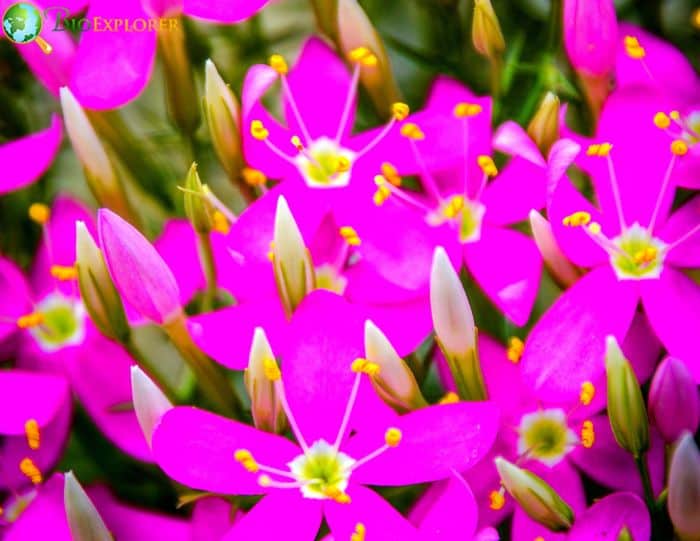
Centaurium beyrichii, or Mountain Pink, is the family Gentianaceae annual herb. The C. beyrichii plants are found in North Central to West Texas.
- The Mountain Pink plant can grow to about 15 to 30 cm.
- The stem of C. beyrichii is smooth (hairless).
- The leaves of the Mountain Pink are sessile, simple, and opposite. They are entire and linear.
- The Mountain Pink flowers are numerous and star-shaped. They are densely packed in much-branched inflorescence. The individual flowers show anthers that are spirally coiled after dehiscence.
- The Mountain Pink plants prefer a sunny situation. Therefore, the substrate suitable for the plant is sandy loam, gritty loam, or sandy clay.
Interesting Facts about Mountain Pink
- The Mountain Pink is poisonous to cattle, sheep, and goats. According to an article[24], the poison dose is approximately 0.5 to 1% of the animal’s body weight consumed daily or for several days.
- John Torrey and Asa Gray first described and validly published Centaurium beyrichii.[25] Benjamin Lincoln Robinson revised and reclassified the plant in 1910.
- The Mountain Pinks[26] are used by the pioneers to reduce fevers.
- Research shows[27] that Mountain Pinks can be a source of xanthones and secoiridoid glycosides, biologically active compounds important for pharmacological use.
- The biologically active compounds from the Mountain Pinks showed antioxidant activity and antimicrobial potential when tested against specific bacteria and fungi.
8. Hill Country Rain Lily
- Plant Type: Perennial herb.
- Common Names: Hill Country Rain Lily, Prairie Lily, Rain Lily, Flor de Mayo.
- Color: White
- Flower Dimensions: 2 inches wide.
- Flowering Seasons/Months: March to August.
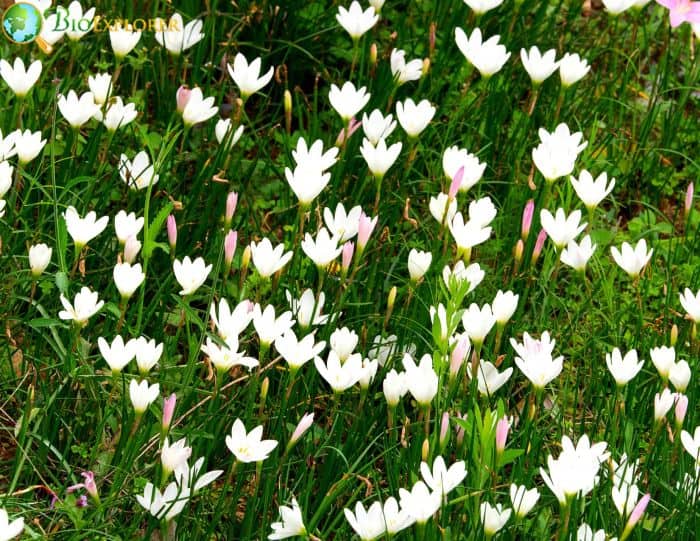
Cooperia pedunculata from the Lily family is a perennial herb that grows and blooms 2-3 days after rain.
- The stem of the C. pedunculata is unbranched and measures 5-9 inches in height. This stem holds a single flower at the top.
- The Hill Country Rain Lilies leaves are at the bottom. The leaf measures 6-12 inches in length by 0.25 inches in width. These leaves are linear and become narrower toward the tip.
- The leaves are present or absent when the flowers bloom.
- The Hill Country Rain Lily flowers are trumpet-shaped with 3 sepals and 3 petals. The flowers are white and measure 2 inches in width at maturity.
- The flowers of the C. pedunculata are fragrant and last only 1-2 days.
Interesting Facts about Hill Country Rain Lily
- The dead leaf tip of the C. pedunculata[28] can cause toxicity to livestock.
- The growth and blooming of the Hill Country Rain Lilies[29] are not scheduled by season. Instead, these plants follow the rain.
- A gum[30], similar to other pharmaceutical gums, was extracted and made from the bulbs of the C. pedunculata.
- The flowers of C. pedunculata open slowly at dusk. During the night, they expand gradually. During the morning, the flower is in full bloom.
- The extracts from C. pedunculata[32] showed insecticidal activity. The aqueous extract from the plant’s leaves is slightly toxic to American and German cockroaches. The aqueous extract from the bulb is effective against American cockroaches and black carpet beetle larvae.
9. Fleabane
| Plantae | Asterales | Asteraceae | Erigeron | Erigeron philadelphicus |
- Plant Type: Herbaceous perennial.
- Common Names: Fleabane, Common Fleabane, Fleabane Daisy, Philadelphia Fleabane.
- Color: White rays with a yellow center.
- Flower Dimensions: each flower head is 0.5 to 0.75 inches across.
- Flowering Seasons/Months: Late spring to mid-summer.
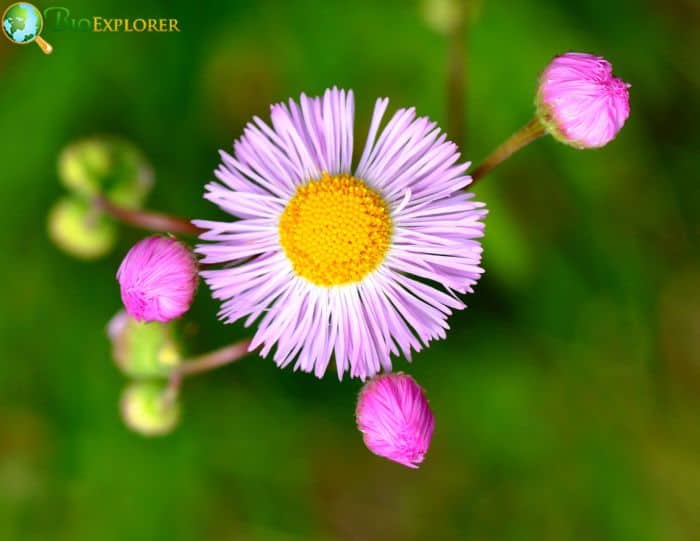
Erigeron philadelphicus is a herbaceous perennial plant of the Asteraceae family. The Fleabane plants typically grow to a height of 30 inches. It grows along roadsides, fields, and woodlands.
- The stem is single-downy, and the upper half is branched.
- The leaves of the Fleabane are alternate, ovate, lanceolate, oblanceolate, or narrowly elliptic. As the leaves ascend, they become smaller and more sparse.
- All leaves of the Fleabane are hairy.
- The flowers of the E. philadelphicus comprises more than 150 white, thread-like rays. The disk flowers at the center are yellow and narrowly tubular.
- Each much-branched stem of the Fleabane plant holds many flower heads.
Interesting Facts about Fleabane
- The genus name Erigeron comes from the Greek words “eri” and “geron“which means “early” and “old man” respectively. The plant’s appearance suggests an older man’s white beard, and the flower’s blooming time is early. The specific epithet philadelphicus[33] means Philadelphia, Pennsylvania.
- The E. philadelphicus plant is called Fleabane because there was a theory that this plant repels fleas.
- The Philadelphia Fleabane[34] was used by the Cherokee and other Native American tribes for medicinal purposes.
- The roots of the E. philadelphicus can be made into tea or chewed to treat colds and coughs.
- A study[35] showed that E. philadelphicus developed resistance to paraquat (a toxic chemical widely used as an herbicide). According to researchers, the concentration of the paraquat should be 50 to 100 times higher than that of other common plants.
10. Butterfly Milkweed
| Plantae | Gentianales | Apocynaceae | Asclepias | Asclepias tuberosa |
- Plant Type: Perennial, woody deciduous shrub.
- Common Names: Butterfly Milkweed.
- Colors: Yellow to orange.
- Flower Dimensions: Flower clusters are 2-6 inches across.
- Flowering Seasons/Months: April to September.
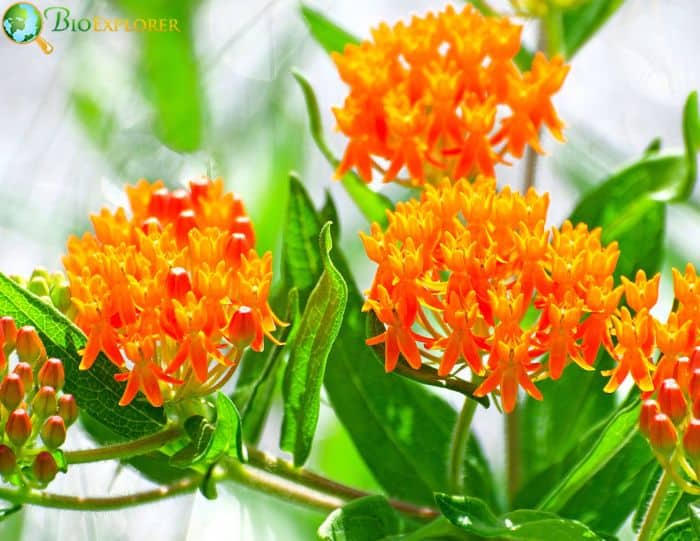
Asclepias tuberosa is a perennial plant native to Texas. Butterfly Milkweed is low to medium growing that usually grows 1-2 feet tall.
- The Butterfly Milkweed is an upright plant with multiple erect to ascending stems.
- The leaves of the Butterfly Milkweed are rough, lanceolate, and sometimes oblong or linear. The leaves are dark-green with the underside lighter green. The leaf measures 2-4 inches.
- The clusters of yellow to orange flowers are on top of the clumps of upright stalks. There are up to 25 flowers per dome-shaped umbel (clusters).
- The flowers have 5 reflexed petals, 5 hairy light green sepals, 5-parted crowns, and 5 curved horns.
- The Butterfly Milkweed plant gets bushier when they get older.
Interesting Facts about Butterfly Milkweed
- Butterfly Milkweed[36] can store food and water in the taproot to survive the long dry summer of Texas.
- The Butterfly Milkweed produces abundant nectar and attracts many butterflies.
- The native Americans and Pioneers boiled the roots of the Butterfly Weeds and used this as traditional medicine. The Indians chewed the tough root of A. tuberosa[37] to be cured of pleurisy and other pulmonary sicknesses.
- The Monarch butterflies occasionally used the Butterfly Weed as a caterpillar food plant.
- Most parts of the Butterfly Milkweed[38] are edible but poisonous if taken in large quantities.
11. Buckley’s Yucca
| Plantae | Asparagales | Asparagaceae | Yucca | Yucca constricta |
- Plant Type: Perennial shrub.
- Common Name: Buckley’s yucca.
- Color: White, green
- Flower Dimensions: 2 inches long by 1 inch wide.
- Flowering Seasons/Months: Spring, summer.
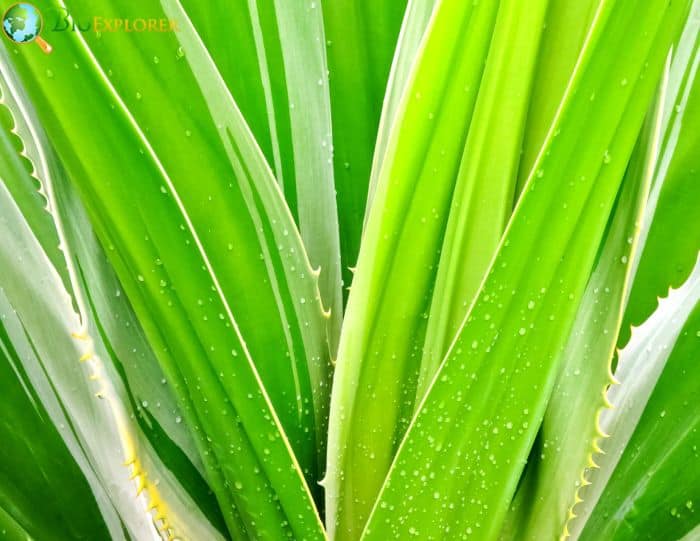
Yucca constricta is a perennial shrub native to Texas. The Buckley’s Yucca belongs to the Agavaceae family, giving showy, ornamental blooms.
- The Y. constricta stems may be absent. If present, it is short and falling over.
- The leaves of Buckley’s Yucca are simple and evergreen. The sharp-pointed leaves are flexible and mostly linear. From the leaf, margins hang the stringy white threads. These leaves measure 2 feet long by 5/8 inches wide.
- The showy flowers are bell-shaped and greenish-white. These flowers are in the inflorescence of a long, large stalk measuring 6 feet or taller.
- Y. constricta plants are hermaphroditesWhat is hermaphrodites?Having both male and female reproductive organs. and can tolerate drought. This plant prefers dry or moist soil.
Interesting Facts about Buckley’s Yucca
- Buckley’s Yucca[39] is a host plant for the Yucca Giant Skipper butterfly.
- The roots of the Y. constricta[40] contain saponins. The saponins are pretty toxic. However, they are poorly absorbed by the human body, eliminating them through waste. According to an article[41], many species that are rich in saponins are used in herbalism.
- The saponins from Buckley’s Yucca are much more toxic to fish. Nevertheless, the hunting tribes put large quantities in the lake and streams to catch fish.
- The flowers, fruits, and stems of Buckley’s Yucca are edible.
- Buckley’s Yucca and the scientific name[42] are given in honor of Samuel Botsford Buckley, an American botanist who described and named this plant.
12. Indian Blanket
| Plantae | Asterales | Asteraceae | Gaillardia | Gaillardia pulchella |
- Plant Type: Annual herb.
- Common Names: Indian Blanket, Firewheel, Indian Blanketflower, Sundance, Girasol Rojo.
- Color: Red, orange, yellow, brown.
- Flower Dimensions: 1.57- 2.4 inches in diameter.
- Flowering Seasons/Months: May to August.
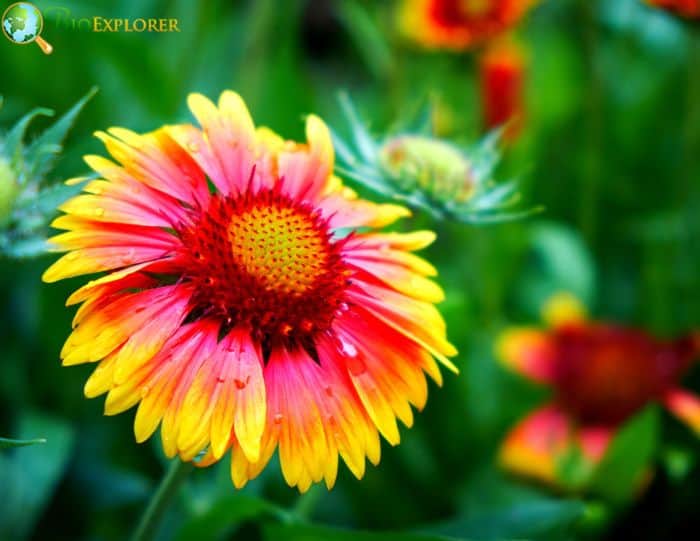
Gaillardia pulchella is an annual herb belonging to the Asteraceae family. This Indian Blanket plant can grow to a height of 1-3 feet.
- The stem of the Gaillardia pulchella is branching, upright, and hairy. It measures 2 feet tall.
- The leaves of the Indian Blanket are primarily basal. They are found at the bottom of the plants. They are alternate and measure 4-8 cm in length.
- The flowers of the Indian Blankets are daisy-like. The flower heads of the G. pulchella are showy. These heads are red at the base and yellow at the tip. At the center of the flower is a brownish-red disk.
- The G. pulchella plants are highly tolerant to salt and drought.
Interesting Facts about Indian Blankets
- The genus Gaillardia is named after the French botanist Antoine Rene Gallard de Charantoneau.
- The moths nestle on the Indian Blanket’s flowerhead to camouflage.
- In 1986, Oklahoma adopted the Blanket Flowe as the official wildflower. Also, the color of Texas State University is maroon and gold. The color choice was influenced by the Blanket Flowers that grow wild on the plains of Texas.
- The blanket flower is considered one of the ingredients for the traditional medicine of the Native Americans. In addition, teas made from plants[44] are used to treat gastrointestinal problems and skin disorders.
- The aerial parts of the G. pulchella[45] have phenolic constituents that manifest anti-inflammatory and hepatoprotective activities. Therefore, scientists stated that G. pulchella has excellent potential to become an anti-inflammatory and hepatoprotective drug.
13. Pink Evening Rose
| Plantae | Myrtales | Onagraceae | Oenothera | Oenothera speciosa |
- Plant Type: Perennial herb.
- Common Names: Pink Evening Rose, Showy Evening Primrose, Mexican Evening Primrose, Showy Primrose, Pink Ladies, Buttercups, Pink Buttercups.
- Color: White, pink
- Flower Dimensions: 1-2 inches across.
- Flowering Seasons/Months: February to July.

Oenothera speciosa, or Pink Evening Rose, is a flowering plant native to Texas. It is an upright to sprawling perennial that forms extensive colonies by spreading.
- O. speciosa spreads using stoloniferous rootstocks and seeds. The Pink Evening Rose can form a ground cover.
- The stems of the Pink Evening Roses are erect. These stems are light green with appressed hairs.
- The leaves of the Pink Evening Rose plants are linear and pinnate. The leaves can sometimes be lance-shaped and entire.
- The flowers of the Pink Evening Roses are large and solitary. They are from the leaf axils. These flowers are composed of four petals in white or pink.
- The O. speciosa plants are drought-resistant. Under drought conditions, their flowers are smaller, approximately 1 inch across.
Interesting Facts about Pink Evening Rose
- O. speciosa[46] is called the Pink Evening Rose because most species open their flowers in the evening and close them again early in the morning.
- The flowers[47] (syrup form) of the Pink Evening Rose are used in treating whooping cough and asthma.
- The seeds of the Evening Primrose[48] plants can produce oil that can be applied to irritated skin because of its calming and anti-inflammatory effects.
- Polyphenols from the stems and the leaves of the O. speciosa[49] are isolated and identified by scientists. The experiment showed that the polyphenols manifest significant antihyperglycaemic, anti-inflammatory, and antioxidant activities.
- In Bulgaria, the phenomenon wherein the diurnal hawk-moth Macroglossum stellatarum is suspended for a long time, sometimes until its death, in the flowers of O. speciosa[50] was observed in several locations.
14. Winecup
| Plantae | Malvales | Malvaceae | Callirhoe | Callirhoe involucrata |
- Plant Type: Perennial herb.
- Common Names: Winecup, Purple Poppy Mallow, Buffalo Rose.
- Color: Pink, white, purple.
- Flower Dimensions: 1.5-2.5 inches wide.
- Flowering Seasons/Months: Early spring to summer.
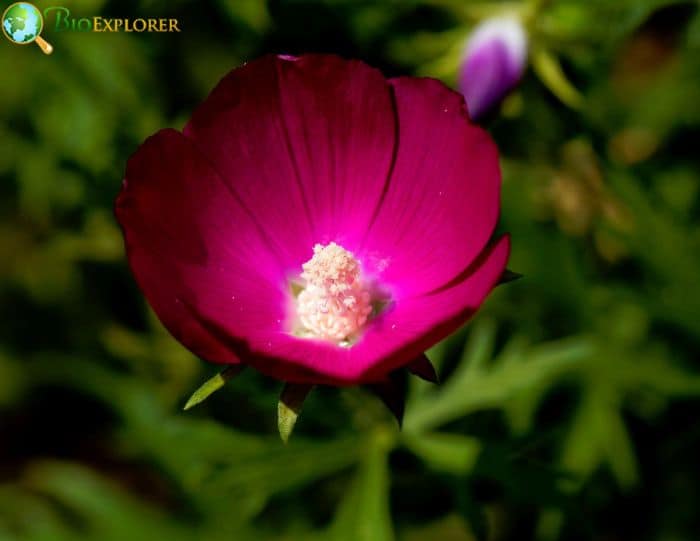
Callirhoe involucrata is an attractive, spreading, perennial herb of Malvaceae. The Winecups are low-growing native plants that can spread 3-4 feet and grow to a height of 6-9 inches.
- The stem of the Winecup plants can form a thick mat and sprawl along the ground.
- The leaves of the Winecups are rounded, hairy, deeply palmately lobed, and cleft.
- The Winecup flowers are borne on the long, axillary stalks of the plant.
- The C. involucrate flowers are chalice-shaped. The flowers have 5 maroon petals. At the center of the flower is a white spot. These flowers measure 1.5 to 2.5 inches in width.
- C. involucrata has a long taproot that enables the plant to tolerate drought.
Interesting Facts about Winecups
- The flowers of C. involucrata[51] close in the evening and open in the morning. After pollination, the flowers remain closed.
- The flowering of the Winecup plants[52] will stop when the temperature rises to 90-95 degrees. Flowering resumes when the temperatures cool.
- The root of C. involucrata is used as a painkiller. It is also used for treating head colds.
- The roots of the Winecups[53] are edible. The Native Americans and early European settlers ate the C. involucrata roots stating that the taste was similar to sweet potato. The leaves of the Winecups are mucilaginous and used as soup and another liquid thickener.
- The genus name Callirhoe is derived from the Greek word “beautiful flowering“. The specific epithet involucrata refers to the involucre (leaf-like structure) below the flower.
15. White Prickly Poppy
| Plantae | Ranunculales | Papaveraceae | Argemone | Argemone albiflora |
- Plant Type: Annual herb.
- Common Names: White Prickly Poppy, Blue Stem Prickly Poppy.
- Colors: White
- Flower Dimensions: 4 inches across.
- Flowering Seasons/Months: March to July.
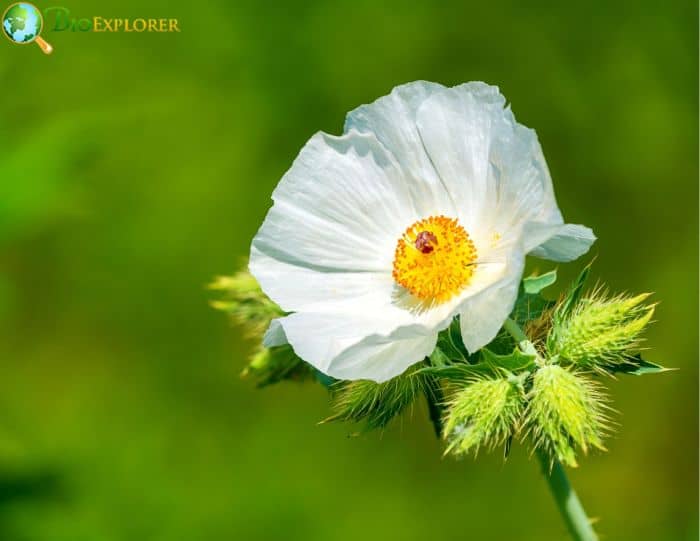
Argemone albiflora, or White Prickly Poppy, is an annual herb of the family Papaveraceae. It is native and widespread in Texas. This plant is upright, deep-rooted, and prickly.
- The stems are bristly, glaucous, and branched.
- The leaves of the A. albiflora are thistle-like and bluish-green. They are pinnately lobed or cleft.
- The leaves of White Prickly Poppy are simple and alternate.
- The flowers of the White Prickly Poppies are white and cup-shaped. They are large with plenty of yellow or reddish stamens. These flowers are borne atop the stems.
- The large and showy flowers from the upper leaf axils have a cymose arrangement. The bract subtends each division of the inflorescence.
Interesting Facts about White Prickly Poppy
- All parts of the A. albiflora plant are highly toxic[54]. The plant contains toxic alkaloids.
- An infusion of the White Prickly Poppy plant treats jaundice, skin ailments, wounds, and colds. In addition, the leaves[55] can be made into a tea that can be used as a laxative.
- The seed oil of the A. albiflora species can cause glaucoma and edema. An article[56] cited that the oil of the A. albiflora was used as an alternative to good lubricant during WWII.
- The leaves of the White Prickly Poppies are spiny and poisonous. The prickly nature of the plant makes the cattle avoid eating the plant even in severe drought periods.
- Argemone[57] is a genus that only contains plants of the New World but is named due to its resemblance to a plant mentioned in ancient Old-World writing.
16. American Basket-Flower
- Plant Type: Annual herb.
- Common Names: Basket-flower, Shaving Brush, Star Thistle, American Basket-Flower.
- Colors: White, pink
- Flower Dimensions: 4-5 inches wide.
- Flowering Seasons/Months: Late spring to summer.
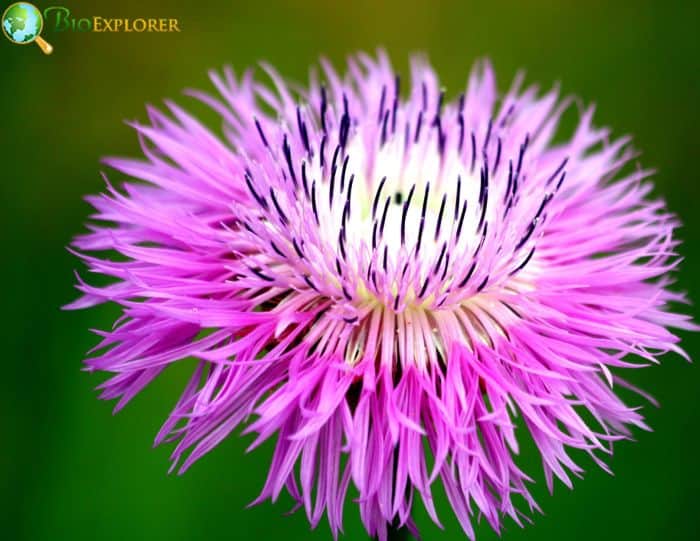
The American Basket-Flower or Centauria Americana is an annual herb flower that resembles the thistles but lacks prickly characteristics. This species belongs to the family Asteraceae.
- Plants of the American Basket-Flower can grow to a height of 24-48 inches and a width of 24-30 inches.
- The stem of the C. americana is much-branched. The stout stems hold the flowers atop. They are erect or ascending.
- The leaves of the C. americana are lance-shaped. These leaves are 3-12 cm long. The yellow to brown resin glands are often present in the leaves.
- The flower heads are filamentous and lavender-pink. The center of the flower is cream-colored. These flowers have a sweet honey fragrance.
- The C. americana flowers are subtended by fringed bracts.
Interesting Facts about American Basket-Flower
- The C. americana species is called Basket-Flower because of the straw-colored bracts beneath the flower heads. The tips of which are divided into long, sharp teeth.
- The genus name Centauria[58] is derived from Greek mythology. It is believed that this flower is used by one of the centaurs for healing after the battle.
- The C. americana[59] is used by the American Indians for venomous bites, indigestion, jaundice, and eye disorders.
- The blossoms of the American Basket-Flower were boiled by the Kiowa for use as cuts and burns salve.
- The C. americana roots have analgesic and antipyretic properties.
17. Eryngo
| Plantae | Apiales | Apiaceae | Eryngium | Eryngium leavenworthii |
- Plant Type: Annual herb.
- Common Names: Eryngo, False Purple Thistle, Leavenworth’s Eryngo.
- Color: Blue, purple
- Flower Dimensions: 2.5 inches.
- Flowering Seasons/Months: Late summer and early fall.
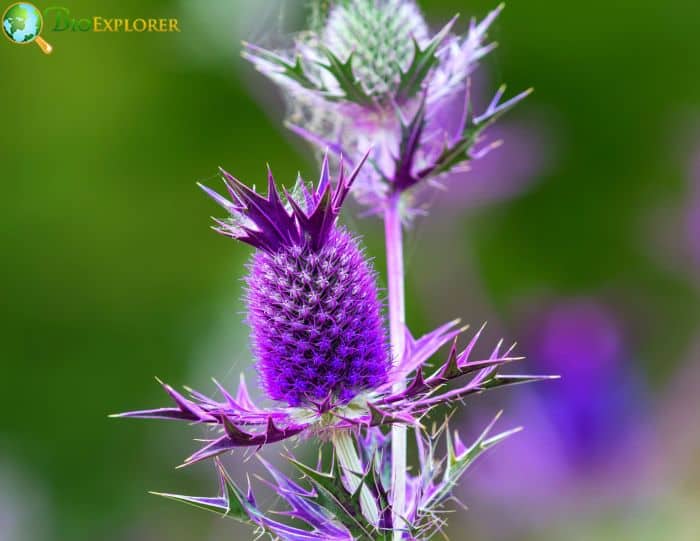
Eryngium leavenworthii is a prickly and showy annual plant of the Apiaceae (Carrot family). Almost the entire Eryngo plant is in the shade of purple.
- The E. leavenworthii stem is erect, stout, glabrous, leafy, and branched above. It measures 20-40 inches in height.
- The Eryngo leaves are deeply lobed. There are stiff spines in the edges and tips of the leaves’ segments.
- The flowers of the Eryngo are minute and also purple. These flower heads resemble small pineapples. Then, a tuft of small and spiny leaves is on the flower head.
- Bright-blue anthers adorned each flower head. The spiny-tipped violet bracts also surround the flower heads.
- The flowers of Eryngo have 5 petals and 5 stamens.
Interesting Facts about Eryngo
- The E. leavenworthii[60] species are not true thistles. However, their appearance and habitat are often confused with thistles due to their similarity.
- The parts of the Eryngo plant[61] are medicinal. It treats menstrual cramps, UTIs, kidney infections, and swelling.
- E. leavenworthii is named after its discoverer, Melines Conklin Leavenworth (1796-1862).
- The Eryngo plant is also used to treat menstrual cramps.
- The Eryngo roots[63] are traditional medicine for specific ailments like urinary tract and kidney problems. Also, it can reduce spasms and can remedy coughs.
18. Water Primrose
| Plantae | Myrtales | Onagraceae | Ludwigia | Ludwigia octovalvis |
- Plant Type: Perennial Herbaceous shrub, aquatic, and hydrophyte.
- Common Names: Mexican Primrose-willow, Water Primrose, Seedbox.
- Colors: Golden Yellow
- Flower Dimensions: 1 inch.
- Flowering Seasons/Months: Summer and fall.
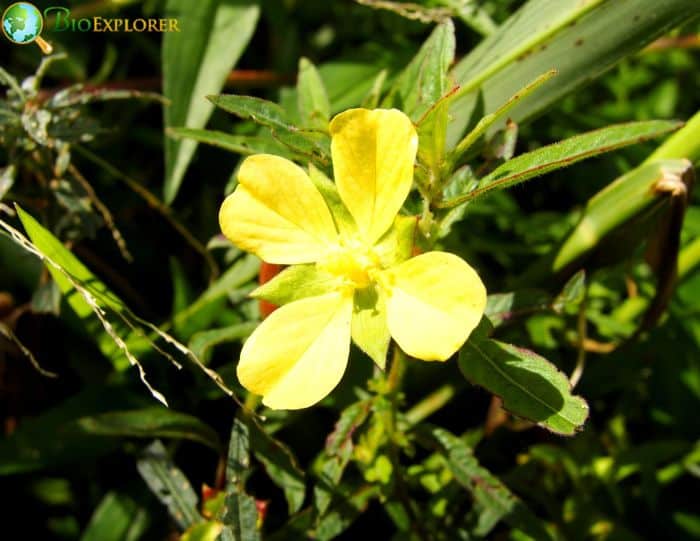
Ludwigia octovalvis, or Water Primrose, is a herbaceous shrub of the Onagraceae family. The Water Primroses grow best in moist or shallow, submerged soils.
- Ludwigia octovalvis plant is a robust and well-branched herb. It can grow up to 3 meters tall.
- The leaves of the Water Primrose are simple and narrowly lanceolate. They measure up to 4 inches in length. The leaves are petiolate to sessile.
- The leaves of the L. octovalvis have sunken venations. The midrib is reddish to pale.
- The Water Primrose flowers are solitary and bisexual. The flower heads are on pedicels from the leaf axils.
- There are four obovate petals in the flower. They are arranged in a cross-like pattern. The petal’s tips sometimes fold down and form a notch-like indentation.
Interesting Facts about Water Primrose
- The Water Primrose or Mexican Primrose-Willow[64] is used to treat skin diseases, diarrhea, and flatulence.
- The L. octovalvis has antioxidant properties. It is also effective for treating diseases caused by E. coli.
- L. octovalvis extract[65] is consumed as a healthful drink daily by many Asians. Therefore, the research[66] was conducted to investigate the anti-aging effects of L. octovalvis using the fruit fly. Results showed that the extract of L. octovalvis significantly increased the fruit fly’s life span.
- A study conducted suggested that L. octovalvis extract is potent for anti-aging intervention. In addition, it can potentially treat disorders related to age.
- Rhizobacteria species are isolated from the roots of Ludwigia octovalvis. Research[67] showed that Rhizobacteria manifest arsenic resistance and biosorption capacity.
19. Texas Shrimp Plant
| Plantae | Lamiales | Acanthaceae | Yeatesia | Yeatesia platystegia |
- Plant Type: Perennial herb.
- Common Names: Montell Bractspike, Wild Shrimp Plant.
- Color: Purplish white
- Flower Dimensions: 0.75 to 1 inch long.
- Flowering Seasons/Months: Summer
Yeatesia platystegia, or Texas Shrimp Plant, is a perennial herb unique to Texas. This plant from the Acanthaceae family grows in Rio Grande Plains and the Edwards Plateau.
- Texas Shrimp Plants are small, woody, and can grow to 30 inches and a width of 2 feet.
- Yeatesi platystegia leaves are deciduous, simple, and opposite. They are entire, lanceolate, and petiolate.
- The Texas Shrimp flowers are spikes of pale lavender fading to white. These flowers are small, approximately ¾ to 1 inch long. They are 2-lipped and 5-lobed. The bracts are conspicuous.
- The Texas Shrimp Plant produces loculicidal capsules.
- Y. platystegia prefers moist soil and a half-shady location.
Interesting Facts about Texas Shrimp Plant
- John Torrey first described and published the name Yeatesia platystegia. In 1989, it was revised and reclassified by Richard A. Hilsenbeck.
- Y. platystegia[68] species are the host plants for the Elf butterfly.
- The prior classification places only 1 species under the genus Yeatesia[69]. Two additional species, Y. platystegia and Y. mabryi were added to the genus.
- The Texas shrimp plant[70] is also called Montell bractspike. They grow prolifically in Montell Canyon in Northern Uvalde County.
- Yeatesia platystegia[71] is considered a rare plant. However, thousands of individual plants form large populations during years of well-precipitation.
20. Sweet Shaggytuft
| Plantae | Lamiales | Acanthaceae | Stenandrium | Stenandrium dulce |
- Plant Type: Perennial herb.
- Common Names: Sweet Shaggytuft, Pineland Pinklet.
- Color: Pink, purplish, almost white.
- Flower Dimensions: 0.5 inches long or less.
- Flowering Seasons/Months: Spring, summer, fall.
Stenandrium dulce, or Sweet Shaggytuft, is a small perennial from the Acanthaceae family. The Sweet Shaggytufts are fast-growing herbaceous wildflowers.
- The stems of the S. dulce can be short or absent.
- The Sweet Shaggytuft’s leaves are basally crowded. The leaf blades are ovate. They can measure up to 1.75 inches in length.
- The flowers are crowded. Each flower comprises a 5-lobed corolla, purplish or almost white. The sepals and the bracts of the flower overlap.
- The fruits of the Sweet Shaggytufts are dry and dehiscent.
- S. dulce is intolerant to long periods of drought. The plant favors moist to wet soils.
Interesting Facts about Sweet Shaggytuft
- S. dulce is a host plant for the Definite Patch butterfly.
- The Sweet Shaggytuft[72] is used by the Seminole tribe as a sedative drug. The S. dulce[73] plant is also used by the Southeastern tribes as pediatric aid.
- “Stenandrium[74] ” means “narrow anthers” and “dulce” means “sweet“. S. dulce species resembles the wheat spike scaly stem, Elytraria bromoides.
- The Stenandrium plants can form many rosettes on the ground from self-seeding. It can maintain social distancing from the competitor plants by making natural herbicides.
- The scientists[75] isolated secondary metabolites from the root and leaf extracts of S. dulce.
21. Purple Pleat-Leaf
- Plant Type: Perennial herb, bulb-forming.
- Common Names: Propeller flower, Purple Pleat-Leaf, Pinewoods Lily, Prairie Iris, Pleatleaf Iris.
- Colors: Blue, purplish
- Flower Dimensions: 1.5 to 2 inches.
- Flowering Seasons/Months: Spring
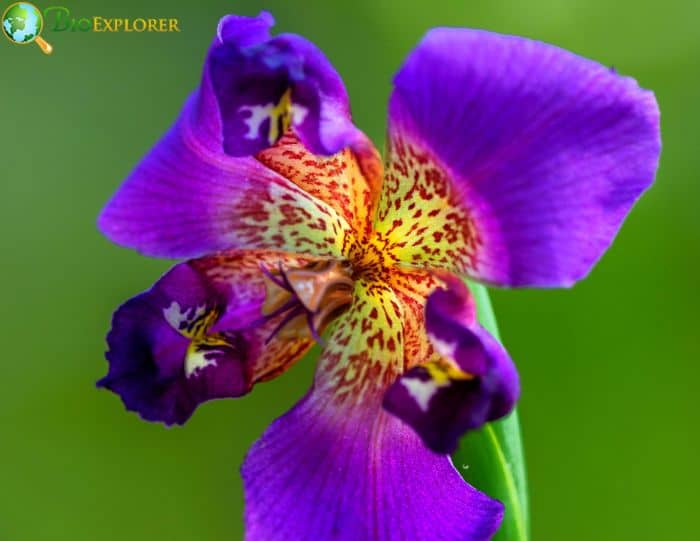
Alophia drummondii is a bulb-forming perennial herb of the family Iridaceae. This usually unbranched plant can grow to 1-2 feet tall.
- Alophia drummondii plants grow from a tunicated bulb.
- The Purple Pleat-Leaf plants can have a simple or 2-branched stem.
- The plant leaves are narrow, pleated, and conspicuously veined. They mostly grow from the base. The leaf typically measures up to 16 inches long.
- These Purple Pleat-Leaf flowers are very showy and resemble the cultivated iris. The flowers are bilateral, and the petals are purplish. Some species have yellow basal mottling.
- The flowers are in a cluster at the end of the stem. They are cup-shaped or flat. The outer tepals are 3; spreading, light to deep purple. The inner tepals are 3; dwarfed, cupped, or crimped.
Interesting Facts about Purple Pleat-Leaf
- The species name Alophia drummondii[76] is given in honor of the naturalist Thomas Drummond (1790-1835) from Scotland, who, in the 1830s, made extensive collections of plants from Central Texas.
- The Wasowski call the A. drummondii[77] an “extraordinarily pretty” wildflower.
- An article published in biodiversity International Journal[78] in 2018 cited that A. drummondii was recorded and identified first time at Paraiba State in Caatinga vegetation, Brazil.
- Parts of the Purple Pleat-Leaf plants[79] are poisonous if ingested.
- The name Alophia drummondii[80] is often misapplied by several authors to Herbertia lahue. The two plants have different vegetative and morphological details.
22. Six Angle Fold Wing
| Plantae | Lamiales | Acanthaceae | Dicliptera | Dicliptera sexangularis |
- Plant Type: Perennial herb.
- Common Names: Six Angle Fold Wing, False-mint.
- Color: Reddish to orange.
- Flower Dimensions: Up to 1.125 inches long.
- Flowering Seasons/Months: Spring
Dicliptera sexangularis is an erect herb of the family Acanthaceae native to Texas. This species can grow to 39 inches tall.
- The six- Angle Fold wings’ stems have surface-hugging hairs at the base. These hairs are also shard and pointed.
- The leaves of the D. sexangularis are opposite and possess stiff hairs. The petioles of the plants are absent or reduced to 3/8 inch in length. The leaf blades are spatulate.
- The Six Ange Fold Wing flowers are showy and bilateral. They are reddish to orange. The corolla is curved and two-lipped. The flowers have 2 stamens.
- The D. sexangularis are plants that can form large colonies.
- The fruit of the Six Angle Fold Wing plants is a capsule that turns brown at maturity.
Interesting Facts about Six-Angle Fold Wing
- The genus Dicliptera is derived from the Greek words “diclis” and “pteron” which means “two” and “wing” respectively. This refers to the open capsule’s winglike appearance.
- The stems of the D. sexangularis[81] have six angles, hence the name.
- The Six Angle Fold Wing[82] plants are larval hosts for the Cuban crescent butterfly.
- The researchers[83] studied the virus that causes symptoms of severe yellow mottle distortion and leaf distortion in the D. sexangularis plant. They designated the virus Dicleptera yellow mottle virus. The scientists stated that it is closely related to Potato yellow mosaic virus from Venezuela.
- D. sexangularis[84] is also called False-mint. This is because the plant’s flowers resemble the flowers of the Mint family, particularly the species Salvia coccinea.
23. Crow Poison
| Plantae | Asparagales | Amaryllidaceae | Nothoscordum | Nothoscordum bivalve |
- Plant Type: Perennial herb.
- Common Names: Crow Poison, False Garlic.
- Color: White with yellow-tinged bases.
- Flower Dimensions: ½ inch across.
- Flowering Seasons/Months: All seasons; frequent after rains.
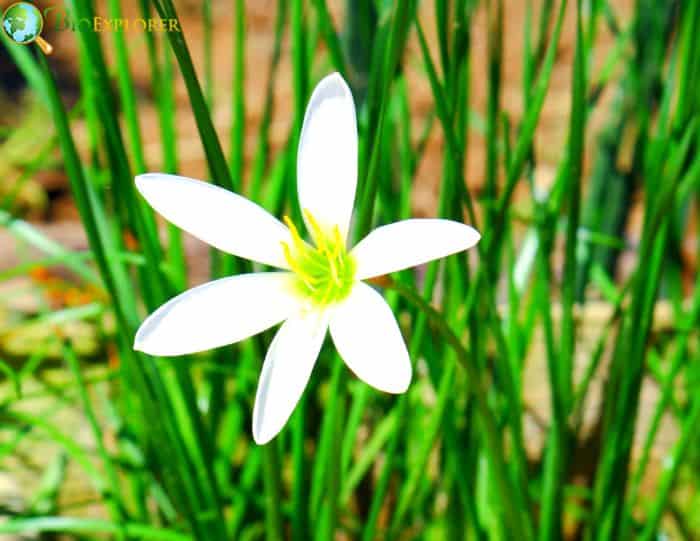
Nothoscordum bivalve is a perennial herb that appears on roadsides and meadows throughout Texas during early spring. This species is a member of the Lily family.
- The Crow Poison plant grows from a bulb. This species looks like a wild onion. The plant can grow about ½ inch long and wide.
- The leaves of the N. bivalves is linear and grasslike. They are all at the base of the plant. Each leaf measures 4-15 inches by 1/8 inch.
- The flowers of the Crow Poisons are composed of 6 tepals. The flowers are in umbels. They are in loose clusters on stalks of about 8-16 inches. Each stalk consists of 6-12 flowers.
- Both the sepals and the petals are white.
- The Crow Poison plant can develop a large colony of various-sized clumps because they can undergo self-seeding.
Interesting Facts about Crow Poison
- N. bivalve[85] is also called False Garlic because it looks like wild garlic or onion but does not have the characteristic odor or taste of the onion or garlic.
- The genus name Nothoscordum[86] is derived from the Greek words “nothos” and “skordo“which means “illegitimate” and “garlic” respectively. Therefore, the members of this genus resemble those of the plants under the Allium, like garlic and onions.
- The specific epithet “bivalve” means “having two valves“. This describes the bracts that surround the flowers before blooming.
- The toxicity of the N. bivalve to crows is not well understood. In addition, the origins of the common name Crow Poison are unknown.
- According to research[87], the methanol extract from the plant Nothoscordium bivalve showed antibiotic activity when tested against the bacteria Acinetobacter baumannii.
24. Texas Tuberose
| Plantae | Asparagales | Asparagaceae | Manfreda | Manfreda maculosa |
- Plant Type: Perennial cactus/succulent.
- Common Names: Spotted tuberose, Spice Lily, Texas Tuberose.
- Colors: Cream to greenish-white flowers, rose-pink at maturity.
- Flower Dimensions: 1.02 inches long.
- Flowering Seasons/Months: Spring, summer.
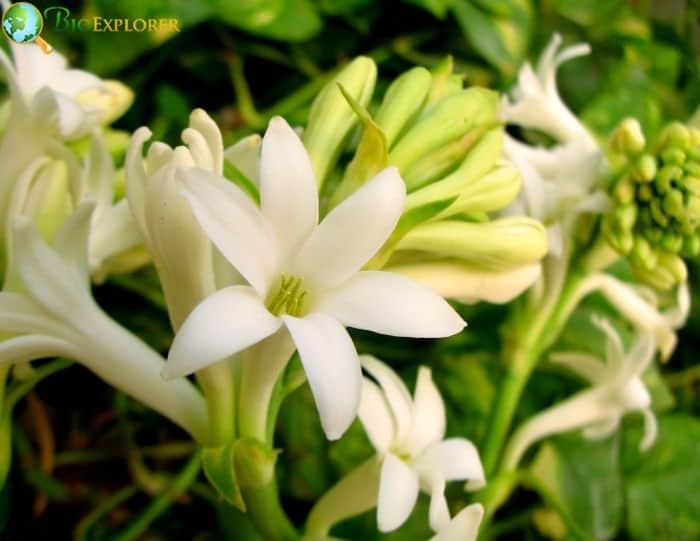
Manfreda maculosa is a perennial cactus endemic to Texas. This species from the Agavaceae family can grow to 5-8 inches.
- Manfreda maculosa plant has an extremely short stem (acaulescent). The Texas Tuberose stems are swollen and underground.
- The leaves of the M. maculosa are evergreen, simple, and lanceolate. They are on the ground in basal rosettes. These leaves are green or brown-spotted. Each measures 8 inches or longer.
- The flowers are bisexual, fragrant, conspicuous, and in long spikes. These flowers are in racemes. The M. maculosa flowers are sessile with 6 tepals fused at the base. Except for a few small bracts, the Texas tuberose’s inflorescence is leafless.
- Every 3-4 days of life, the flowers of M. maculosa change colors.
Interesting Facts about False Aloe
- The M. maculosa is a host plant for the Manfreda Giant Skipper butterfly.
- The National Butterfly Center[88] is requesting the assistance of the citizens of Travis County in conducting the native plant survey. This is to search for the species Manfreda maculosa and Manfreda longiflora. Since the two species are limited in number, the butterfly’s population that depends on its host is also affected.
- The specific epithet “maculosa” means “spotted“. This refers to the patterns in the leaf.
- The indigenous North American[89] people used the rhizomes of the False Aloe to make soap and shampoo.
- The genus “Manfreda” is given in honor of Manfredus de Imperiale, a 14th-century Italian medical scholar, and writer.
25. Texas Wrightwort
| Plantae | Lamiales | Acanthaceae | Carlowrightia | Carlowrightia texana |
- Plant Type: Perennial subshrub.
- Common Name: Texas Wrightwort.
- Color: White
- Flower Dimensions: 0.25 inch long.
- Flowering Seasons/Months: Spring, summer, fall.
Carlowrightia texana is a creeping perennial of the family Acanthaceae. This plant has minute hair and grows up to 12 inches tall. C. texana is native to Texas.
- The young stems of the Texas Wrightworts are quadrate to terete.
- The leaves of the Texas Wrightworts are opposite, ovate, and lanceolate. The petioles can be absent or very short if present. Each leaf measures 0.75 inches by 0.5 inches.
- Usually, the flowers of C. texana is in dichasia in leaf axils.
- The C. texana flowers are bilateral. They are white with maroon veins. Each flower has 4 lobes and a narrow tube. The flowers are sessile to subsessile.
- The fruit is a 4-seeded capsule.
Interesting Facts about Texas Wrightwort
- The genus Carlowrightia is derived from the name of the American botanist Charles Wright.
- The C. texana is similar in appearance to C. parviflora. However, the leaves of the C. texana are twice as long as they are broad, while the C. parviflora leaves are thrice or more times longer than they are broad.
- James Solberg Henrickson and Thomas Franklin Daniel described and validly published Carlowrightia texana[91] in 1979.
- The Carlowrightia[92] belongs to the bear’s breeches family (Acanthaceae). The species belonging to this family are called wright-worts.
- Texas Wrightworts[93] is the most common Carlowrightia found in Trans-Pecos. The Trans-Pecos is the only part of Texas where the habitats of mountains and desert are found.
Texas is famous for its wildflowers. These flowers are beautiful with purpose. They provide habitat for wildlife, help in water conservation and erosion control, and support the state’s bee population. The increase in bee population is essential since they boost the ecosystem and economy by pollinating other plants, like the farm crops that are worth millions of dollars. Furthermore, these beautiful wildflowers minimize the Texas costs of maintenance and labor since less mowing and care are needed in the areas where these flowers grow.
The wildflowers provide many benefits to Texas. Though it is not against the law, many Texans are taught not to pick these wildflowers early on. The Texas Department of Transportation (TxDOT) has programs to maintain, preserve, and encourage the growth of Texas native flowers in the state’s right of way. The State of Texas offers natural and beautiful patches of blooms for the world to see and appreciate.
What is your favorite Texas flower?
![]()



